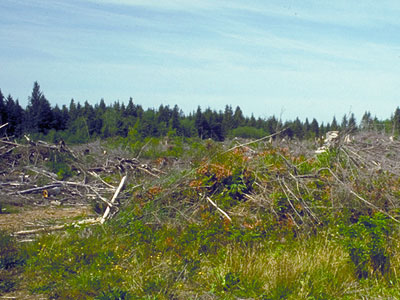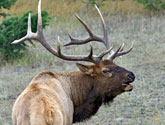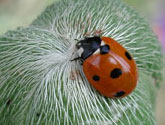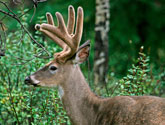
Home |
About Us |
How to Participate |
Biodiversity Modules |
Projects |
Maps |
News |
Resources

Home |
About Us |
How to Participate |
Biodiversity Modules |
Projects |
Maps |
News |
Resources
|
Definition of "Non-Forest" - General Code 600: Grasslands, mountain meadows, un-maintained range, clear cuts, as well as young replanted forests with trees less than 15' tall and have less than 26% canopy cover. |
Non-Forest: Clearcut (611)

| Descriptive Habitat Code: Clearcut is non-forest (6), recently disturbed (1), and
sparsely vegetated; 60-90% bare ground (1).
Clearcutting is a forestry/logging practice in which the majority of all trees in a forest sector are cut down. Photo: KMD |
 American Black bear Ursus americanus Code: URAM Photo: Natures Pics | Distribution and
Habitat: It is found in mountainous, forested, and wetland habitats Diet: Interesting fact: |
 Coyote Canis latrans Code: CALAT Photo: RA |
Distribution and Habitat: It is found in mountainous areas, grasslands, deciduous and mixed coniferous forests and even urban areas. Diet: Interesting fact: |
 Elk Cervus elaphus Code: CEEL Photo: Natures Pics |
Distribution and Habitat: Elk are widespread in Washington and found in a variety of habitats such as shrub steppe, bunchgrass, shrub plant communities, open meadows near open or closed canopy forests. Diet:
Interesting fact:
|
 Lady beetles (aka Ladybugs) Photo: TFK |
Distribution and Habitat: Ladybugs are found all over the world. They have many different patterns. Diet: Interesting fact: |
 White-tailed Deer Odocoileus virginianus Code: ODVI Photo: Natures Pics |
Distribution and Habitat: White-tailed deer are found in North America from southern Canada through Central America. Deer prefer open woodland, but are often found on the fringes of urban areas and in farming country. Diet:
Interesting fact:
White-tails, particularly the young, are preyed upon by bobcats, mountain lions, coyotes, and wolves. |
Home |
About Us |
How to Participate |
Biodiversity Modules |
Projects |
Maps |
News |
Resources